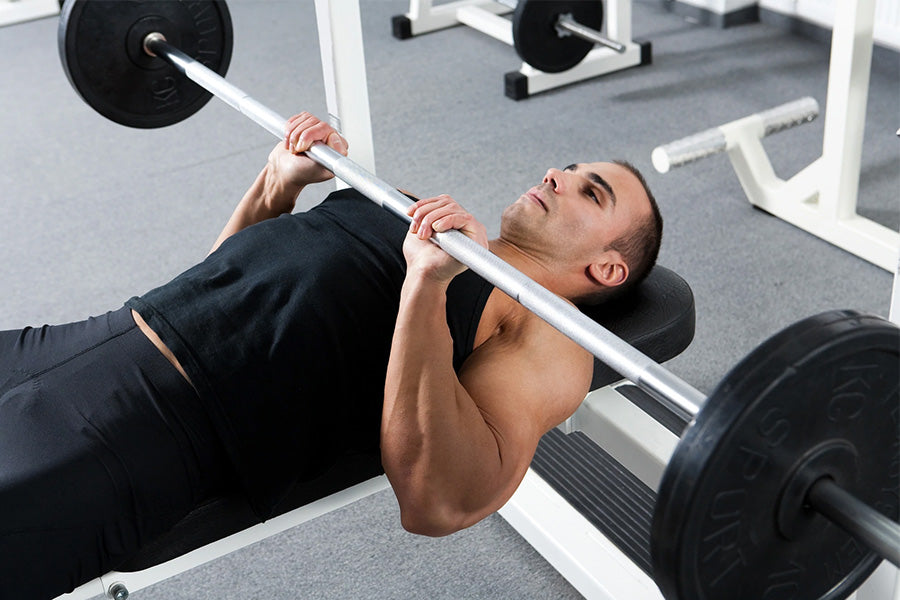The Close Grip Bench Press is a compound exercise focusing on the triceps and inner chest muscles. It involves pressing a barbell closer than shoulder-width from the chest.
This variation of the classic bench press targets the triceps muscles more intensely, while still engaging the pectorals and deltoids. By narrowing the grip, lifters can isolate the triceps, enhancing arm strength and definition. This exercise not only contributes to upper body muscular hypertrophy but also plays a crucial role in increasing overall pushing strength.
It’s a staple in many strength training and bodybuilding routines due to its effectiveness in developing the upper body. Perfecting the form is essential to maximize the benefits and minimize injury risks, making it a suitable choice for intermediate to advanced fitness enthusiasts seeking to challenge their upper body workouts.

Credit: www.dmoose.com
Unveiling The Power Of Close Grip Bench Press
The Close Grip Bench Press stands as a mighty tool for upper body strength. It shifts the focus away from the chest, zooming into the triceps. Right execution leads to remarkable power and muscle gains. It is a favorite among weightlifters eager to enhance their arm strength.
Targeting The Triceps
Triceps activation takes center stage with this exercise. A narrower grip forces the triceps to work harder. This focus on triceps growth leads to stronger, more defined arms.
- Better elbow stability
- Increases pressing power
- Beneficial for arm-dominant sports
Comparing Close Grip To Traditional Bench Press
Differences in grip width distinguish these exercises. Each targets distinct muscle groups.
| Exercise | Main Muscles Worked | Grip Width |
|---|---|---|
| Close Grip Bench Press | Triceps, shoulders | Shoulder-width |
| Traditional Bench Press | Chest, triceps, shoulders | Beyond shoulder-width |
The Close Grip Bench Press reigns supreme for triceps building, while the traditional bench press is a solid choice for overall chest development.
Getting Started: Proper Form And Technique
The Close Grip Bench Press is a powerful exercise. It targets the triceps and chest muscles. Mastering the technique is crucial. This guide dives into the details of hand placement and elbow alignment.
Hand Placement And Elbow Alignment
Proper hand placement ensures safety and maximizes muscle engagement. Here’s how to set up:
- Lie flat on the bench with eyes under the bar.
- Place hands shoulder-width apart.
- Wrap thumbs around the bar for a secure grip.
Elbow alignment affects which muscles work the hardest. Keep the following in mind:
- Tuck elbows slightly, about 45 degrees to your body.
- Avoid flaring elbows out to prevent shoulder strain.
Breathing And Repetition Guidelines
Controlled breathing is essential for performance and safety. Adhere to these basics:
- Inhale while lowering the bar towards the chest.
- Exhale forcefully when pushing the bar upward.
Consistency in repetition builds strength and muscle endurance. Start with:
- 3 sets of 8-12 reps for beginners.
- Adjust rep count according to fitness goals.
- Take a 60-second break between sets.
Incorporating Close Grip Bench Press Into Your Routine
The Close Grip Bench Press is a dynamic exercise. It targets the triceps effectively. Beginners and seasoned lifters can benefit from it. This addition to your routine can advance upper body strength. The key is to incorporate it correctly.
Designing An Effective Tricep Workout
Tricep development requires focused exercises. A well-rounded workout routine includes the Close Grip Bench Press. This exercise complements other tricep-focused movements. It ensures comprehensive muscle engagement.
- Start: Warm-up with lighter weights.
- Volume: Incorporate 3-4 sets of 8-12 reps.
- Progress: Gradually increase weight while maintaining form.
- Variety: Combine with tricep dips and overhead extensions.
Balancing Push And Pull Movements
Equilibrium in your workout plan is vital. Balance push exercises like the Close Grip Bench Press with pull movements. This balance prevents muscle imbalances. It promotes joint health.
| Push Exercise | Pull Exercise |
|---|---|
| Close Grip Bench Press | Bent-over Rows |
| Shoulder Press | Pull-ups |
| Push-ups | Face Pulls |
Include equal reps and sets for both movements. Listen to your body. Adjust your routine based on comfort and fitness levels.
Credit: www.quora.com
Avoiding Common Mistakes And Injuries
The Close Grip Bench Press is a potent exercise for building arm and chest strength. Yet, without proper technique, injuries can occur. This section spotlights key pitfalls to avoid and how to exercise safely.
Recognizing Signs Of Poor Form
Poor form is a primary cause of injury during the Close Grip Bench Press. Pay attention to these tell-tale signs:
- Wrist pain may indicate incorrect grip or wrist alignment.
- Excessive shoulder strain suggests a grip that’s too narrow.
- A swaying back can be a sign of too much weight or fatigue.
- Elbow flare reduces tricep engagement and can stress the shoulders.
Preventative Measures And Safety Tips
Consistent, injury-free Close Grip Bench Press sessions require a focus on safety. Here are essential tips:
- Proper Warm-Up: Begin with dynamic stretches to ready the muscles and joints.
- Spotter Assistance: A spotter can provide feedback on form and safety.
- Appropriate Weight: Start with lighter weights to perfect the form.
- Steady Progression: Gradually increase weight to build strength safely.
- Wrist Wraps: Consider wrist support if experiencing discomfort.
Keep movements controlled. Avoid locking out the elbows at the top of each repetition. Regular breaks between sets allow for muscle recovery.
| Exercise Segment | Focus Point |
|---|---|
| Setup | Align wrists and position grip |
| Execution | Lower bar with control to mid-chest |
| Recovery | Maintain form and monitor fatigue |
Measuring Your Progress: Strength And Aesthetic Gains
The close grip bench press targets your triceps like no other exercise. As you continue with your training routine, you’ll want to track your progress. Strength gains and improved aesthetics are both key indicators of advancement. Let’s dive into the specifics of measuring your development.
Tracking Your Tricep Development
Notice the changes in your triceps over time.
- Start by taking before and after photos.
- Measure your arms every two weeks to monitor increases in size.
- Keep a workout log to track the weight and reps over time.
- Perform a max rep test monthly to assess endurance improvements.
Consistency is key to seeing a significant transformation.
Setting Realistic Goals And Milestones
Setting goals helps maintain focus and motivation. Goals should be attainable and specific.
- Set short-term goals, such as increasing the weight lifted by 10%.
- Create medium-term goals, for example, adding an inch to your triceps.
- Establish long-term goals like achieving a full body transformation.
Mark milestones in your training diary. Celebrate when you reach each one.
Maintain patience and remain diligent. Progress will come with time and effort.
| Time Frame | Goal Type | Example |
|---|---|---|
| 1 Month | Short-Term | Increase weight by 5% |
| 3 Months | Medium-Term | Perform 20% more reps |
| 1 Year | Long-Term | Total tricep size increase |

Credit: www.strengthlog.com
Supplementary Exercises For Maximal Tricep Growth
The Close Grip Bench Press is a powerhouse for building tricep strength. To maximize growth, we pair it with targeted exercises. Together, they create a dynamic routine for tricep development. Our triceps consist of three heads: the long, medial, and lateral. To fully engage each, we’ll explore supplementary exercises designed for peak results.
Isolating Triceps With Accessory Work
Accessory exercises fine-tune tricep growth. They target each head, leading to impressive definition and size. Try adding these movements to your workout:
- Tricep Kickbacks: Hinge at the waist, use dumbbells, and extend your arms.
- Overhead Tricep Extensions: Stand or sit, hold weights above your head, and bend your elbows.
- Dips: On parallel bars or a bench, lower your body, and push up through your arms.
- Skull Crushers: Lie on a bench, hold a barbell or dumbbells, and hinge your elbows.
- Cable Pushdowns: Use the cable machine, select a grip, and push the attachment down.
Rotate these exercises into your tricep days. Focus on form and control to engage the muscle fully.
Combining Compound Movements For Overall Development
Compound exercises build mass and overall strength. They engage multiple muscles alongside the triceps. Include these to work your triceps and more:
| Exercise | Muscles Worked |
|---|---|
| Diamond Push-Ups | Chest, triceps, shoulders |
| Military Press | Shoulders, triceps, upper back |
| Push Press | Legs, core, shoulders, triceps |
| Bench Press | Chest, shoulders, triceps |
Start with lighter weights. Increase them as you gain strength. This approach ensures constant progress without injury. Combine these with your Close Grip Bench Press for a tricep-focused, full-body workout.
Frequently Asked Questions On Close Grip Bench Press
What Does Close Grip Bench Press Work?
The close grip bench press primarily targets your triceps, while also working chest muscles and front deltoids.
Where Do You Put Your Hands On A Close Grip Bench Press?
Place your hands on the barbell around shoulder-width apart, ensuring a firm grip for stability during the close grip bench press.
What Is The Difference Between Regular And Close Grip Bench?
Regular bench press utilizes a wider grip, working chest muscles more. Close grip bench press involves a narrower grip, focusing on triceps and inner chest.
Why Is Close Grip Bench Harder?
Close grip bench presses are harder because they emphasize triceps strength over chest muscles, requiring greater upper body stability and potentially reduced leverage for lifting the weight.
Conclusion
Embracing the close grip bench press can revolutionize your upper-body training routine. This variation targets your triceps and chest with precision. Incorporate it for enhanced strength and a refreshing challenge. Remember to maintain proper form to reap maximum benefits and prevent injuries.
Now, gear up and press on towards your fitness goals!


